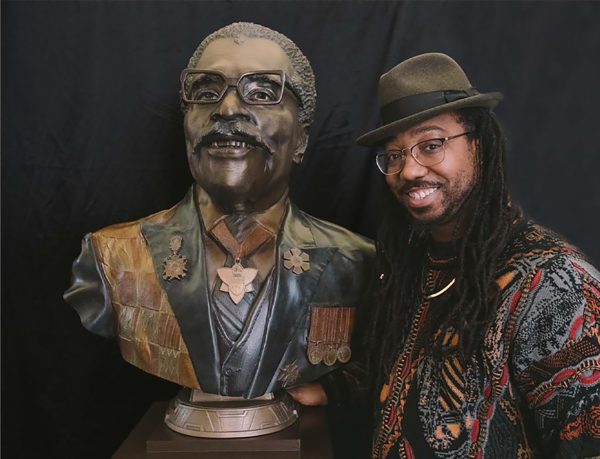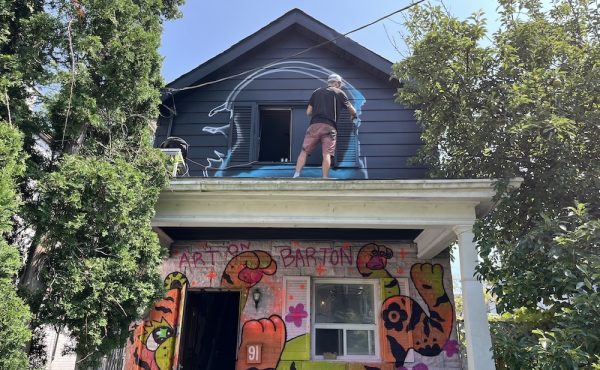This piece is co-authored by Dr. Cheryl Thompson and Daysha Loppie
Many statues have commemorated white historical figures in Toronto’s public spaces: Canada’s first prime minister, Sir John A. Macdonald at Queen’s Park, which was raised in 1894; the equestrian statue of Edward VII, erected in 1969; and the notorious Edgerton Ryerson statue, installed in 1889, that once stood at the heart of now-Toronto Metropolitan University’s campus.
Some of these statues have met strange but fitting ends. A replica of Edward VII was found dumped in the Don Valley River in 2017. Sir John A. Macdonald was boarded up in 2020 following “incidents of vandalism,” according to one Toronto Star article, and to this day remains in its vertical wooden coffin. Then, in the summer of 2021, Black and Indigenous activists toppled Ryerson and removed him using a truck.
Reflecting on Black History Month 2024, we’re writing this piece to ignite discussion about the ways in which Black history is now commemorated, via the installation of monuments and statues which provide acts of memorial in spaces and places that were previously the exclusive domain of white historical figures.
In fact, since 2020, the year that was dubbed as a “racial reckoning” with colonial history, there is another kind of reparation on the rise — the erection of statues to commemorate Black historical figures.
We’d propose two ways of looking at this cultural turn. On the one hand, it is a necessary step toward recognizing the contributions of Black people in Toronto. On the other, these statues mainly represent Black Caribbean men who made a difference in the city — a trend that is consistent with a patriarchal pattern of not paying homage to Black women when it’s due.
In 2021, for example, artist Quentin VerCetty completed work on a bust of Black abolitionist Joshua Glover in the Etobicoke park (25 Ackley Heights) which bears his name. Glover, who came to Canada via the Underground Railroad, lived and worked in Etobicoke until his death in 1888.
Then, this past January, a bust of Lincoln Alexander, Canada’s first Black federal MP and former Ontario Lieutenant Governor-General, was unveiled at Queen’s Park. Alexander, who died in 2012 at age 90, is one of the first Toronto-born Black persons to be memorialized in the city’s public spaces.
Between 1968 and 1980, Alexander represented the riding of Hamilton West, and served as Ontario’s Lieutenant Governor-General from 1985-1991. In addition to this bust, he is also remembered on a Canada Post stamp, several schools and a Hamilton expressway, completed in 1997. In 2021, TMU’s newly established faculty of law was named the Lincoln Alexander School of Law.
It’s of course important that Black people whose existences are woven into the fabric of this country see themselves represented in its public spaces. It’s a matter of equity and reconciliation. But it’s just as crucial that the opportunity to do so is not taken for granted. We need to be extremely intentional about who we commemorate, the ways in which we commemorate those individuals, and how we situate them in time and space.
In 2021, Beverly Mascoll (1947-2001) — whose trailblazing beauty supply stores, Mascolls Beauty Supply, which distributed products across Canada in the 1970s and 1980s — was commemorated with a historical plaque that sits outside Bathurst subway station. This plaque is one of a few that commemorate Toronto Black women. The other recalls Mary Ann Shadd. Her plaque, erected in the St. Lawrence Market in 2012 by Heritage Toronto on King Street East just east of Church Street, acknowledges the location where Shadd served as the first Black woman to edit a newspaper, The Provincial Freeman, a 19th-century anti-slavery publication.
Clearly, Toronto loves its Black commemorative monuments, plaques, and busts. But the question is how do we make these moments matter more than signposts that a Black person did something significant in a particular place? How can commemoration move from the voyeuristic act of looking (and hopefully reading) to real pedagogy, learning, and deep respect for the contributions of Black people — men and women — to Toronto’s and Canada’s economic, cultural, and political landscape?
Taking up space, and holding place, are necessary parts of Black liberation. But like many initiatives towards this goal, they can become performative. What happens after the blog post is written, the family and political figures pose for pictures, and the media coverage ends? If there is commemoration without consistent and active reflection and critique, then what purpose do these commemorations serve?
At Queen’s Park, our current Progressive Conservative government appears to be doing all the right things as far as recognition of Black people is concerned. Premier Doug Ford acknowledged anti-Black racism in his Emancipation Day messages. Minister of Citizenship and Multiculturalism Michael Ford made a Black History Month launch post on X. And Education minister Stephen Lecce announced in February this year an additional $16.5 million in the Black Youth Action Plan (BYAP) to support more than 20 community-based and culturally focused organizations. He also announced that Black history curriculum will become mandatory in grades seven, eight, and ten History classes across Ontario, starting in September 2025.
At the same time, Black community leaders have rallied at Queen’s Park against what they saw as threats to anti-racism, diversity, and equity training in Ontario schools. Furthermore, since 2020, the Black Class Action Secretariat (BCAS), a not-for-profit committed to addressing systemic discrimination in Canada’s public services, has been fighting a class action lawsuit against the federal government on behalf of nearly 30,000 Black civil services employees who allege that they have been harmed by discriminatory practices since the 1970s.
On a systems-level, governmental changes, public ceremonies, and financial declarations of support appear to be moving us in the right direction. However, as Black women, we still experience microaggressions and, in some instances, blatant racism. In the context of education, students are still not fully learning about Black people or Black history at the university or college levels.
It’s great that the curriculum will be changed, but is there a commitment to hire more Black teachers and promote Black teachers to administrative positions? Celebrating Black heritage days and months is wonderful, but what do governments and school boards do during the rest of the year? How do we hold them accountable?
We need to go beyond representation for representation’s sake, which can be quite hollow and definitely won’t withstand the test of time. Instead, there must be a deep, ongoing exploration of intentions, purposes and biases within Black communities. Black women historically were leaders of revolutions, both intimate and grand, but often did not receive recognition for the efforts because Blackness does not neutralize the ways in which men who are Black still benefit from broader systems of patriarchy.
The memorials to Lincoln Alexander and Joshua Glover represent a start. But we would be naive to accept them as a final form of restorative justice. There are no statues commemorating Black women historical figures in Toronto. What we need is a more expansive push towards a kind of equity that considers the diversity of Black historical lives and the stories associated with Black people in spaces and places. When it comes to statues or busts or plaques, we need to go beyond performative unveilings.
photo courtesy of Quentin VerCetty
Cheryl Thompson is an Associate Professor of Performance at Toronto Metropolitan University. She is director of Black Creative Lab and MobaProjects and can be reached on X @DrCherylT.
Daysha Loppie is a journalist based in Toronto and a former student of Dr. Thompson. She is graduating from Toronto Metropolitan University with a Bachelor of Journalism and a minor in Black Studies. Read more of her publishing writing.




